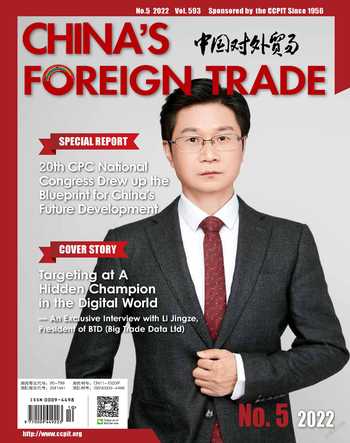China’s Livestreaming Enters A New Phase of Development
By Lily Wang
As the internet technology and the livestreaming industry develops, livestreaming platforms have mushroomed, and more and more users have flocked into this new industry.
Recently, the Ministry of Culture and Tourism of China released the“Development Report on Chinas Online Show (Livestreaming) Industry(2021-2022)” (herein after referred to as the report). The report shows that in 2021, the value of Chinas online show(livestreaming) industry amounted to RMB 184.442 billion. By December 2021, the number of livestreamer accounts reached 140 million and the number of active accounts within the year is approximately 100 million. Meanwhile, the livestreaming industry is transforming from “live broadcast+” to “+live broadcast”. This has produced many new business models and created about 20 types of new job positions. Local governments have issued supportive policies to construct livestreaming e-commerce industry bases, in order to promote the development of the livestreaming economy.
During the pandemic control and prevention, Chinas livestreaming industry became an important platform for promoting economic recovery. The growth of Chinas internet celebrity economy and the increase of MCN institutions have made China lead the world in the livestreaming industry. In addition, as the livestreaming marketing emerged and became popular, Chinas market has shown great resilience and vitality and has witnessed an acceleration in the digital transformation of real business.
Livestreaming industry becomes pillar of the platform economy
According to the Statistical Report on Chinas Internet Economy Development, as of June 2020, the number of online livestreaming users in China has reached 562 million, an increase of nearly 30% over last year and accounting for nearly 60% of the total number of internet users. According to the report, which was released by KPMG and the Alibaba Research Institute, the market size of Chinas livestreaming e-commerce in 2019 reached RMB 438.8 billion, with a penetration rate of about 4%; the overall scale of livestreaming e-commerce was estimated to be RMB 1.05 trillion in 2020, with a penetration rate of 8.6%; the number reached RMB 2 trillion in 2021, with a penetration rate of 14.3%. As a dividend of “mobile + industry”, the explosive growth of the livestreaming economy has been recognized by the whole industry.
Besides this, a survey data from iiMedia shows that in 2019, Chinas smart phone users spent 134 minutes on their phones every day. Shopping, social interactions and videos have been reorganized into an entertainment experience model to meet the needs of different groups of consumers. The livestreaming economy could achieve direct C2C communications and share product performance and life concepts without interference from business enterprises due to its pan-entertainment characteristics. Online shopping could transform into a type of social consumption including entertainment.
T he nu mb e r of Ch i n as livestreaming users has also achieved stable growth and surpassed 600 million in 2021. It is estimated that the number of users will reach 600 million in 2022. Nowadays, watching online broadcast programs has become a habit for many people. These live programs cover games, shows, life entertainment and livestreaming e-commerce. The huge number of livestreaming users is the precondition for livestreaming business operators to make profits. In the realm of mobile e-commerce, despite the number of users being expected to reach 869 million in 2022, the growth rate has dropped. As the e-commerce system is further improved in China, the number of users will reach a ceiling equivalent to the number of netizens, and the costs of gaining a network flow will keep rising. “Livestreaming + e-commerce” will become another trend in the livestreaming industry.
Research shows that the after more than 10 years of development, the livestreaming industry has become the pillar of the platform economy, with a solid industry pattern, diversified market entities, and a well-segmented market. In terms of industrial environment, with the extension of platform business and the improvements in the industrial chain, livestreaming platforms have become an important vehicle for crosssector integration, and constantly promote technology upgrades and business ecological reconstruction in the production and circulation fields. In terms of social environment, both central and local governments have issued regulatory and supportive policies. Livestreaming has shown great momentum in terms of rural revitalization, tourism performance, public welfare and value guidance. It has been seamlessly integrated across all walks of life.
Livestreaming industry shifts its focus from incremental business to stock business
Recently, investment has extended to all parts of the livestreaming industry. Capital has been invested in MCN institutions, livestreaming operation institutions, livestreaming agencies and other livestreaming platforms.
Moreover, the online-offline integrated marketing model has become popular in business circles. Many enterprises have invested in e-commerce to promote product sales through livestreaming and social marketing. The participation of professional livestreaming operation teams is very significant to this process. Meanwhile, driven by the digital economy, the relationship between livestreaming and all sectors has changed, and all sectors have been trying to seek new development opportunities through livestreaming.
The development report shows that livestreaming platforms have been playing a more important role in developing business industries, nurturing digital talents, and creating cultural and tourism opportunities in rural regions.
In promoting the development of rural industries, livestreaming marketing and farmer-helping live rooms are implemented to promote agricultural sales and create more jobs for rural farmers. As new business models and types of farmers emerge in rural regions, livestreaming and videos have become the window through which to showcase the rural image and beautiful scenery, and to promote the new business models of the cultural tourism industry.
Insiders in the industry said that although online sales had been the main channels for some products, high-value products (especially industrial products) still heavily rely on the real physical channels. Buyers are more willing to complete transactions through on-site experience and comparison. However, the multi-dimensional characteristics of the livestreaming economy can largely make up for the shortcomings of earlier online transactions, and will include a large number of products of business and consumer terminals to form a huge market. Considering the change in consumption habits by transaction efficiency, this market space is not a replacement for original demands, but represent an increase in the whole market scale.
The functions of the livestreaming economy have further expanded. They now include not only transaction businesses, but also all types of business forms with a derived value. Experts say that the livestreaming industry shows its unique social value and strong communication capacity. It fully leverages the new technology and business model to make positive contributions towards promoting consumption recovery, alleviating the pressure caused by the economic downturn, stabilizing employment and promoting rural revitalization.
Furthermore, the cloud travel model of the tourism industry has also been improved. “Cloud travel”, “cloud exhibitions” and “cloud room booking”have led to the emergence of many new business models. Homestay owners have recently started relying on livestreaming to increase their fan bases and win more customers. Online tourism platforms like Trip, Mafengwo and Tuniu have expanded their livestreaming businesses to explore the “tourism + livestreaming”business model through livestreaming marketing and cloud tourism. The show business has also been exploring“cloud shows” and increasing new sales channels, such as online paid performances, tickets and peripheral products.
The livestreaming industry has shifted its focus from incremental business to stock business. The concept of the livestreaming economy has been accepted by more and more people and opportunities in the industry still exist, but the industry still requires more intensive development for the future.
Correct guidance and increased regulation as top priorities
The rapid grow th of the livestreaming economy is also coupled with market disorder and problems. It is imperative to create correct guidance and enhance regulation in the industry to make the industry develop in a healthy and sustainable way.
This year, many government departments have issued multiple measures to tackle the issues which have appeared in the livestreaming industry.
On May 7, the CPC Central Civilization Office, the Ministry of Culture and Tourism, the National Radio and Television Administration, and the Cyberspace Administration of China issued the Opinions on Regulating Online Livestreaming User Contribution and Strengthening the Protection of Minors, and further standardized user contribution and anchor behaviors.
Since April, the Central Cyberspace Office, together with the relevant departments, has carried out a three-month special action of “clearing up the chaos in livestreaming and short videos”, focusing on illegal and unregulated content such as “erotic content, ugliness, oddities, fake news, vulgarity and gambling”, and strictly tackling such prominent problems as industrial dysfunction, “online celebrity chaos”, over-contribution by livestreaming users, illegal profit making and malicious marketing.
In March, the Cyberspace Administration of China, the State Taxation Administration and the State Administration of Market Regulation announced the joint issuance of the Opinions on Further Standardizing the Profit Making Behavior of Online Livestreaming and Promoting the Healthy Development of the Industry, which focuses on building a longterm mechanism for cross-department collaborative regulation, strengthening the guidance on profit making behavior in online livestreaming, and encouraging and supporting the lawful and compliant operation of online livestreaming.
In addition, in November 2020, the relevant national departments also successively issued the Guiding Opinions on Strengthening the Regulation of Online Livestreaming Marketing Activities, the Regulations on the Management of Internet Livestreaming Marketing Information Content Services (Draft for Comments), the Notice on Strengthening the Management of Online Shows and E-commerce Livestreaming and other rules and regulations. This reflects the regulatory authorities focus on the sound development of the livestreaming industry.
In fact, these national policies were made not only to regulate the livestreaming industry, but also to promote and guide industrial development.
Since 2021, both the national and local governments have attached great importance to the great value of livestreaming in stimulating the digital economy and helping with rural revitalization, and have issued a number of policies to help build a livestreaming industry base and cultivate talents. The purpose of this is to support the development of the livestreaming economy and new business models through real investments and favorable policies.
In 2021, the National Development and Reform Commission, together with the Ministry of Commerce, the Cyberspace Administration of China and other departments, issued a series of policies to support the livestreaming economy, such as the Implementation Plan for Accelerating the Cultivation of New Consumption, the E-commerce Development Plan During the 14th Five-year Plan Period, the Guiding Opinions on Expanding the Multiple Functions of Agriculture and Promoting the High Quality Development of Rural Industries, and the Action Plan for Improving the Digital Literacy and Skills of the Whole of Society. These policies put forward many valuable proposals, such as“developing the livestreaming economy, encouraging government-enterprise cooperation to build livestreaming bases, strengthening the training of livestreaming talents”, “encouraging the use of new carriers, such as short videos and live broadcasts, to create a better rural ecology”, “promoting the popularization of new e-commerce models such as livestreaming e-commerce and short video e-commerce in rural areas”,“developing new business formats such as livestreaming sales, farmer-assisted livestreaming rooms, mobile vegetable baskets, and cultivating livestreaming farmer salesmen”.
At the local level, tax incentives, talent support, financial security, capital incentives, base construction and other measures have become the“standard configuration”. For example, the governments of Guangzhou and Shanghai have made clear proposals to build “the capital of livestreaming e-commerce” and “the highland of livestreaming e-commerce”. Hangzhou is focusing on “the high-quality development of new e-commerce”, and Beijing has proposed the goal of “the turnover of livestreaming e-commerce reaching RMB 1 trillion” this year.
In terms of industry self-discipline, the development report points out that as part of the digital economy, the livestreaming industry has been playing a key role in rural revitalization, industrial integration, cultural and tourism development, public welfare, and employment promotion. Each part of the industrial chain, including MCN institutions, anchors, users, etc., is becoming more and more professional. An obvious trend is the awakening to the awareness of “knowledge payment”in the livestreaming field. Usersdemand for cultural consumption has increased, and the transmission cost of professional content has decreased. The improved quality of content, plus more rational users, will promote the regulated development of the livestreaming industry.
With the rapid development of livestreaming industry, more and more platforms have recognized the importance of continuously producing high-quality content. It is said that Tiktok e-commerce has recently launched the “spring rain plan”, the first phase of which will provide a traffic flow of 20 billion for incentives on creations, improve the exposure of highquality content, cultivate high-quality content creators, encourage merchants and experts to create high-quality e-commerce content, and improve its long-term operating efficiency. The person in charge of the platform said that, compared with ordinary users, users who have created high-quality content continuously are 50% more efficient at growing their fan bases. In terms of core indicators such as fans attention, stay, and interaction performance, it makes sense that e-commerce accounts with high-quality video content will clearly exhibit a better performance.
- China’s foreign Trade的其它文章
- The Development of Foreign Trade in China over Last Decade:Higher-level Opening-up to the Outside World
- New Changes in Travel:Past Visitors Are Become Today’s Experiencers
- The Pension Industry Calls for New Models and Ecology
- Digital Technology Promotes China-foreign Trade in Agricultural Services
- As Shipping Costs“Dive”,It Is Imperative to Improve the Layout of Industrial Chain
- China Manufacture“Prepares”for World Cup

